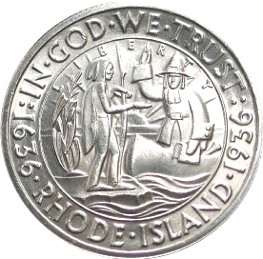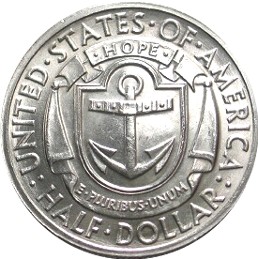Rhode Island Tercentenary half dollar facts for kids
| United States | |
| Value | 50 cents (0.50 US dollars) |
|---|---|
| Mass | 12.5 g |
| Diameter | 30.61 mm |
| Thickness | 2.15 mm (0.08 in) |
| Edge | Reeded |
| Composition |
|
| Silver | 0.36169 troy oz |
| Mintage | Philadelphia: 20,013 including 13 pieces for the Assay Commission
Denver: 15,010 including 10 assay coins |
| Mint marks | D, S. Beneath the corn stalk on the left-hand side of the obverse. Philadelphia Mint pieces struck without mint mark |
| Obverse | |
 |
|
| Design | Roger Williams meeting a Native American |
| Designer | John Howard Benson and Arthur Graham Carey |
| Design date | 1936 |
| Reverse | |
 |
|
| Design | Anchor; adaptation of the Seal of Rhode Island |
| Designer | John Howard Benson and Arthur Graham Carey |
| Design date | 1936 |
The Rhode Island Tercentenary half dollar is a special coin made by the United States Mint in 1936. It's a fifty-cent piece that was created to celebrate the 300th anniversary of Providence, Rhode Island. Even though it was for Providence, the city's name isn't actually on the coin!
The coin was designed by two artists, John Howard Benson and Arthur Graham Carey. On the front, it shows Roger Williams, who was the person who founded the Colony of Rhode Island and Providence Plantations.
Lawmakers from Rhode Island wanted a coin to mark this important anniversary. A senator named Jesse Metcalf added the idea for this coin to another bill that was already being discussed in Congress. Both parts of Congress agreed, and President Franklin D. Roosevelt signed it into law. A total of 50,000 of these coins were made at the three different mints in the country.
The coins went on sale on March 5, 1936, and they sold out incredibly fast, in just a few hours! However, some people in Rhode Island who were involved with the coin held back many of them. They planned to sell them later for a higher price. This made coin collectors very upset. This kind of behavior eventually led Congress to stop making so many special commemorative coins. Today, these coins can be worth hundreds of dollars, depending on how good their condition is.
Contents
Roger Williams and Rhode Island's Beginnings
Roger Williams was born in Britain around 1603. He became a minister and a Puritan, which was a group of Christians who wanted to "purify" the church. He moved to the Massachusetts Bay Colony and became a minister there.
However, the leaders of the colony didn't like some of his ideas. For example, he believed that church and government should be separate. He also thought that land should be bought fairly from Native Americans. Because of these ideas, he was forced to leave the colony in 1635.
Instead of going back to Europe, he escaped and found help from Massasoit, a leader of the Narragansett people. In 1636, Roger Williams bought some land from Massasoit and started a new settlement called Providence Plantations. This settlement later joined with others to form the Colony of Rhode Island and Providence Plantations, which eventually became the state of Rhode Island.
How the Coin Idea Started
In 1931, a group was formed to plan the 300th anniversary of Roger Williams founding Providence. People like Senators Jesse H. Metcalf and Peter Gerry, and Representative John Matthew O'Connell, pushed hard to get a special coin made for this event.
Back in 1936, the government didn't sell commemorative coins directly. Instead, Congress would choose an organization to buy the coins from the United States Mint at their face value (like 50 cents). Then, that organization would sell them to the public for a higher price, making money for their anniversary celebration. For the Rhode Island coin, the Providence Tercentenary Commission was chosen to do this.
A bill for another special coin, the Hudson Sesquicentennial half dollar, had already passed in the House of Representatives. When this bill was being discussed in the Senate, Senator Metcalf suggested adding a part to it for the Providence Tercentenary half dollar. No one objected, and the bill passed the Senate. The House of Representatives then agreed to the changes, and President Franklin D. Roosevelt signed it into law on May 2.
Designing the Special Coin
John Howard Benson, one of the coin's designers, wrote a letter in December 1935 explaining how the design process went. He and Arthur Graham Carey were chosen to design the coin because they had experience making small medals.
The committee in charge of the anniversary originally wanted seven stars from an old Providence seal on one side of the coin. On the other side, they wanted the anchor from Rhode Island's state seal and the motto "Hope." However, the committee changed their minds. They then wanted to show Roger Williams meeting Native Americans on the front of the coin. They even decided to hold a public contest for the design. Benson and Carey kept working on their ideas, made the changes, and entered the contest. Their design was chosen!
The Commission of Fine Arts, a group that approves designs for public art, looked at the designs. They approved them on December 20. After that, larger plaster models of the designs were shrunk down to coin size by the Medallic Art Company in New York.
What the Coin Looks Like
The Front (Obverse) Design
The front of the coin shows Roger Williams kneeling in a canoe, with his hand raised in a sign of friendship. A Native American is greeting him, with their hand extended palm down, which was a native sign for "good." Behind the Native American, there's a stalk of corn. This reminds us of how Native Americans helped the Mayflower Pilgrims when they first arrived in America.
In Williams' other hand, he holds a Bible, which represents the colonists' contributions to America. The Sun is rising in the background, symbolizing that Rhode Island was the first colony where people were guaranteed religious freedom. The word LIBERTY is above their heads, showing the main idea of the design. The words IN GOD WE TRUST, RHODE ISLAND, and the anniversary dates (1636-1936) are around the scene.
The Back (Reverse) Design
The back of the coin features the Anchor of Hope, which comes from Rhode Island's state seal. The motto HOPE represents the authority of the state government. The national motto, E PLURIBUS UNUM (which means "out of many, one"), is also on this side, showing the authority of the federal government. The name of the country, UNITED STATES OF AMERICA, and the coin's value, HALF DOLLAR, surround the design.
It's interesting that the name of Providence isn't on the coin anywhere, even though it was made for Providence's anniversary. Some coin experts have different opinions on the design. One expert, Anthony Swiatek, thought Roger Williams looked a bit like a "robot." However, another expert, Q. David Bowers, said that no one really criticized the design much.
Making and Selling the Coins
The purpose of this bill is to stop a racket in the issuance of commemorative coins that has developed in recent years. ... Then in April it was announced [that the Providence coins] had sold out in 6 hours. The astonishing part of it is in the entire State of Rhode Island there were only five members of the American Numismatic Association, which is the largest organization of coin collectors in the United States. Where did all the coins go? This Providence dealer immediately raised his price to $7.50 a set, and the next month raised it to $9. He admitted securing 11,500 for orders that he had, then later offered 50 sets to trade and 25 to sell. ... Here is what happened to the collectors. The commission accepted their money. Then, after all were sold, sent most collectors back their money, saying that they had sold them all to natives, but the money sent back was not the original money orders and checks sent in, but checks from the commission. ... Was the coin collectors' money used to send to the mint to get the coins?
About 20,000 of the half dollars arrived in Providence from the Philadelphia Mint by February 20, 1936. Another 15,000 coins were expected from the Denver and San Francisco Mints. These coins were made in January and February of 1936. A small number of coins from each mint were also kept aside for testing by the United States Assay Commission.
The Quick Sell-Out and Controversy
March 5, 1936, was a very busy day for the coin's release. The new coins went on sale through various banks in Rhode Island for $1 each. The Rhode Island Hospital National Bank was the main place to get them. People from other states could order them from Grant's Hobby Shop in Providence, owned by a well-known coin collector named Horace M. Grant.
Within hours, banks claimed they were out of coins, and it was announced that the entire issue had sold out in just six hours. However, it turned out that many coins were still available from people "on the inside," including Horace Grant, but at much higher prices.
In those days, it was common for distributors to hold back special commemorative coins. They would wait for prices to go up before selling them. Horace Grant advertised the coins in April 1936 for $7.50 for a set of three (one from each mint), or $2.75 for a single coin. By June, he was selling sets for $9.
Collector Anger and Changes
Coin collectors were very angry about this situation, and some even filed lawsuits against the commission. One coin dealer, L.W. Hoffecker, dropped his lawsuit after he received 90 sets of the coins. He later complained to other dealers and to Senator Metcalf about how unfair the distribution was. He suggested that if more coins were made, a neutral party should handle the sales so they wouldn't be hoarded again. He felt that "every bank in Rhode Island is making a lot of money, instead of distributing the coins."
Because of these problems, Congress eventually stopped allowing new commemorative coin issues in 1939. The Rhode Island Tercentenary Committee was later closed down. They had made a profit of $24,000 from the 50,000 coins. About two-thirds of that money went towards building a memorial for Roger Williams.
A popular coin guide, A Guide Book of United States Coins (often called the Red Book), notes that the coin's distribution "was wrapped in controversy." It mentions "phony news releases" saying the coin was sold out when it wasn't, and that some dealers bought large amounts cheaply to resell for big profits.
By 1940, the price of a set of three coins had dropped to $4.50 on the secondary market (where collectors buy from each other). But then the price steadily rose, reaching $975 during a coin collecting boom in 1980. In 2017, the Red Book listed the coin between $325 and $675 for a set of three, depending on its condition. A single coin is usually about a third of that price. A nearly perfect coin from the San Francisco Mint sold at auction in 2014 for $6,463!

